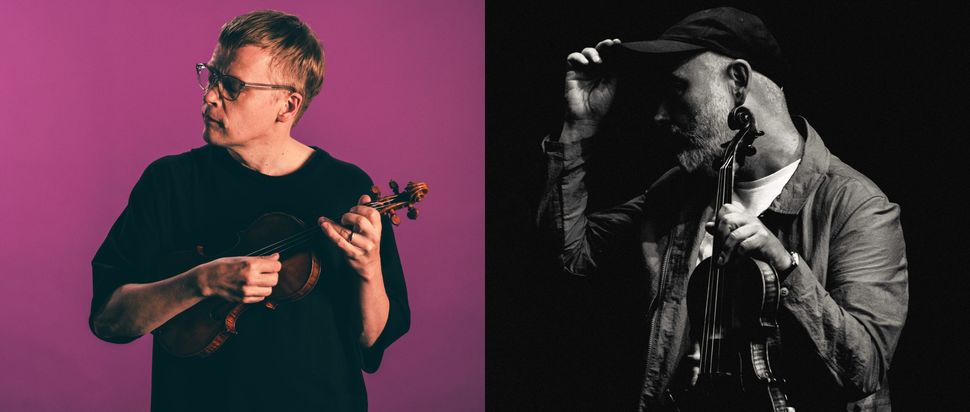Pekka Kuusisto and Aidan O'Rourke on SCO's Time and Tides
Ahead of the SCO's forthcoming Time and Tides performances, we catch up with fiddle players Pekka Kuusisto and Aidan O'Rourke to discuss the marriage between traditional and classical styles
Aidan O’Rourke (virtuosic fiddle player) is waxing lyrical about Pekka Kuusisto (virtuosic fiddle player) when Kuusisto himself joins the call. (This writer: grade five violin, 2005.)
“We were just talking about you,” says O’Rourke.
“Oh shit,” replies Kuusisto.
“Pekka, I was just saying how you’re one of the few classical violinists who can really authentically cross traditional and classical genres. It’s a very difficult thing to do, but you’ve nailed both,” explains O’Rourke.
“Ah well, in that case, don’t let me interrupt,” Kuusisto replies, laughing.
There’s clearly a great deal of love and respect between these longtime friends and some time collaborative performers. Kuusisto, from Finland, is an exceptional violinist and conductor so heralded within the world of contemporary classical music that his achievements are too long to list. He is celebrated for his modern and energetic approach. O’Rourke is an equally exceptional player. Originally from Argyll, he is best known for his band Lau in which he has used his distinctive and expressive style of playing to interrogate the roots and boundaries of traditional Scottish and Irish music.
Kuusisto is a student of traditional music too, devoting a great deal of work to promoting the marriage between classical and traditional styles. “I didn't grow up with traditional music, but fortunately I had some stuff in my upbringing that wasn't purely classical violin,” says Kuusisto. “So I began getting into trad Finnish and Nordic music at the age of 20, I suppose. My life as a fiddle player, as a musician, would have become significantly less fun had I not discovered it.”
The two have been brought together again by the Scottish Chamber Orchestra for several upcoming evenings built around SCO alumna Anna Clyne’s violin concerto Time and Tides. O’Rourke and Kuusisto will play the song, alongside a celebratory set of traditional songs, as a duo, including music which influenced Clyne’s piece. O’Rourke had lent some expertise and other material which fed into Clyne’s exploration of traditional music.
“I sent Anna this Scottish tune, an old work song – a rowing song actually. There's a lot of songs going back to the 17th and 18th centuries that were used for rowing, called iorrams,” says O’Rourke. “These are beautiful songs, they feel like air. They’re not rhythmic tunes – not meant to be sung and rowed to in time. It was more about feeling the intensity of the sea, I guess.”
Traditional music and classical repertoire may not immediately seem a match: each has a reputation for being, respectively, spontaneous and earthy, the other more mannered. But Kuusisto, O’Rourke and Clyne are committed to breaking down that barrier.
Kuusisto explains by way of metaphor – one about coloured directional lines running through the corridors of a hospital, another about circumventing roadworks on the journey to your favourite coffee shop – that classical performance can benefit from the personality of a more improvisatory trad music playing style. “Most of the repertoire that we play, we make a point of playing exactly what's on the paper as much as possible," Kuusisto says. "Of course, we allow the music hopefully to breathe, and how we emphasise certain notes and feel the harmonies will always happen in the moment, but we don't come up with arrangements or alternative decorations to the melodies. We don't change that. When somebody comes into a classical music situation and does do that, then it's immediately a massive departure from what usually goes on.”
These upcoming concerts showcase another way that the SCO has attempted to democratise, and create accessibility within, contemporary classical music. “It's only in the last 30 years that [traditional music has] been put onto the world stage as a respected performance art,” says O’Rourke. “It was seen as music for in the house, the village halls, music for dancing to, to share with friends and the community. It wasn't really concert music. It’s cool to see it being presented and broken down so clearly ahead of the performance of Anna’s concerto.”
Kuusisto adds: “Now it's impossible to imagine getting a violinist education, even a purely classical violin education, without being really exposed to things like Scottish and Irish traditional music, or traditional music from India, the Balkans, or Hungarian trad music – it’s influenced so much of our standard repertoire.”
O’Rourke goes on: “It’s all about connections and the exchange of ideas. The Nordic fiddle tradition is really present in Scotland just now, that goes right back to the sharing of songs by whalers and fishermen in the 1600s. These exchanges go back hundreds of years, and maybe just a continuation of that.”
Kuusisto says wryly: “I do feel like a whaler sometimes."
Few things can epitomise the bridges between classical and traditional music more than when Kuusisto, with genuine awe and respect, asks O’Rourke what he would do to show a symphony orchestra’s violin section how to play like him. “I’d show them how to hold the bow completely wrong,” laughs O’Rourke.
Time and Tides, Holy Trinity Church, St Andrews, 13 Mar; The Queen's Hall, Edinburgh, 14 Mar; City Halls, Glasgow, 15 Mar
